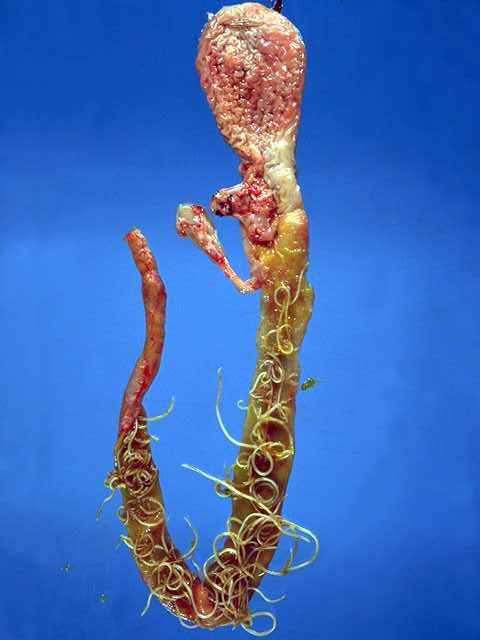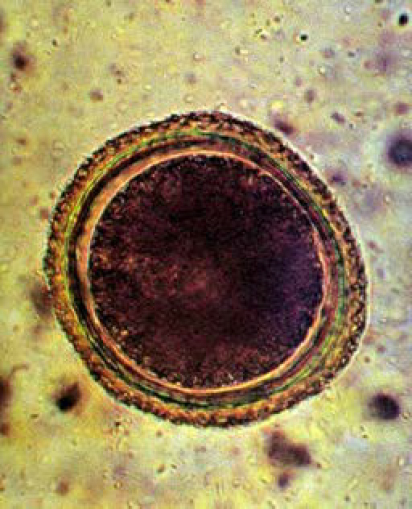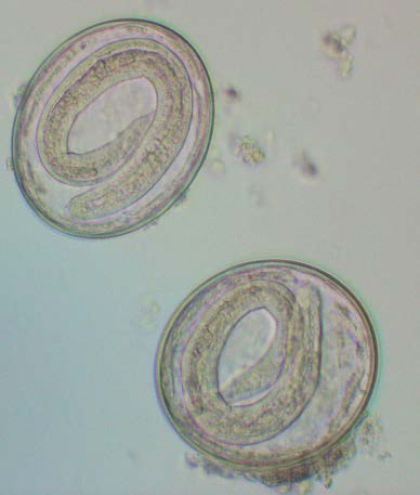Roundworms
(Toxocara canis, Toxascaris leonina)
Roundworms are nematodes that can infect domestic and wild canids and felids. Animals become infected when they ingest eggs containing infective larvae. Toxocara canis primarily affects puppies, producing signs of enteritis, and it is zoonotic.
Distribution
Worldwide.
Clinical signs
In neonates and puppies, heavy infections via the transplacental route may result in pneumonia and acute death owing to enteritis and gastrointestinal blockage as early as 10 days of age. Heavy burdens with T. canis in pups may produce ill thrift, stunting, abdominal discomfort (pups adopt a straddle-legged posture and a pot-bellied appearance), anorexia, diarrhoea and vomiting (adult worms may be expelled). Occasional gastrointestinal obstruction (Fig 1) and death may result. Toxascaris leonina infection is usually asymptomatic.
Diagnosis
Detection of thick-shelled (pitted for Toxocara (Fig 2), smooth for Toxascaris (Fig 3)) eggs on standard faecal flotation (S.G. 1.20) (SOP 1). Immature worms may still produce clinical disease in puppies. Therefore, the absence of eggs in faeces does not rule out infection. In this case, treatment and examination of expelled worms is recommended.

Figure 1 Adult worms of Toxocara canis exposed within the small intestines of a dog. (Image credit: The University of Melbourne parasite image library)

Figure 2 Toxocara canis egg on faecal flotation showing pitted surface. (Image credit: Dr. R. Traub)

Figure 3 Toxascaris leonina eggs on faecal flotation showing smooth surface. (Image credit: Dr. R.Traub)
Treatment
For anthelmintic treatment options refer to Table 1.
Anthelmintic therapy should be combined with supportive care (e.g. fluid and electrolyte therapy) where necessary.
Table 1 Routes of application, dose and efficacies of commonly utilised anthelmintics against the primary gastrointestinal parasites of dogs.
Control
Puppies should be treated with a registered anthelmintic labelled for use in puppies at 2 weeks of age (to prevent vertically acquired infections becoming patent) and then every 2 weeks until 8 weeks of age. Treat the dam at the same time. Following this, dogs should be dewormed monthly. Refer to Table 1 for details on recommended frequency of administration for individual anthelmintics. For further control options, refer to the General Considerations and Recommendations section.
In adult dogs, there is a high probability that T. canis infection will result in somatic migration with larvae in the tissues. Therefore, an absence of T. canis eggs in adult dogs does not rule out infection, as arrested larvae may re-activate during pregnancy to infect pups in-utero.
Off-label use of anthelmintics that significantly reduce the burden of vertical and trans-mammary transmission of T. canis from dam to pups has been described in published literature. These include:
- Topical selamectin applied at 6 mg/kg at 40 and 10 days pre-parturition and 10 and 40 days post-whelping [1].
- Fenbendazole 50 mg/kg daily, day 40 to 14 days post-whelping [2].
- Ivermectin SC administered at 300 µg/kg body weight on days 0, 30 and 60 plus 10 days post whelping [3].
Public health considerations
Ingestion of embryonated T. canis eggs in the environment may produce covert, ocular or visceral larva migrans. Children are most at risk owing to their behaviour. Once ingested the larvae undergo somatic migration to organs such as the liver, lungs, brain and eye. Such migration may be asymptomatic or alternatively, larval migration can lead to an eosinophilic inflammatory response producing clinical symptoms such as abdominal pain, fever, hepatomegaly and cough. Symptoms are usually self-limiting, but may lead to serious complications if there is neurological or cardiac involvement. Toxocara canis larvae may enter the eye and its vasculature causing blindness or decreased vision due to retinochoroiditis, optic neuritis and endophthalmitisendophthalmitis.
References
[1] Payne-Johnson M, Maitland TP, Sherington J, Shanks DJ, Clements PJ, Murphy MG, McLoughlin A, Jernigan AD, Rowan TG. Efficacy of selamectin administered topically to pregnant and lactating female dogs in the treatment and prevention of adult roundworm (Toxocara canis) infections and flea (Ctenocephalides felis felis) infestations in the dams and their pups. Vet Parasitol. (2000) 91:347-358.
[2] Burke TM, Roberson EL. Fenbendazole treatment of pregnant bitches to reduce prenatal and lactogenic infections of Toxocara canis and Ancylostoma caninum in pups. J Am Vet Med Assoc. (1983) 183:987-990.
[3] Payne PA, Ridley RK. Strategic use of ivermectin during pregnancy to control Toxocara canis in greyhound puppies. Vet Parasitol. (1999) 85:305-312.

